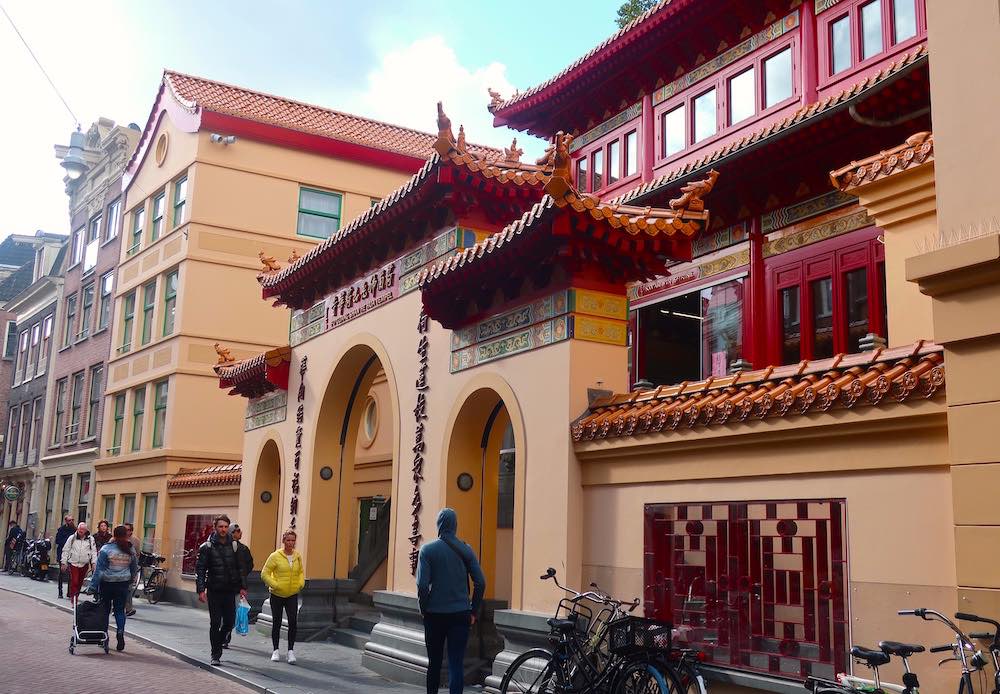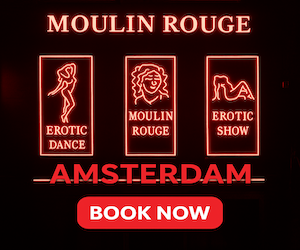Chinese He Hua Temple
The Chinese He Hua Temple in Amsterdam
The Chinese He Hua Temple in Amsterdam feels hidden—yet it’s the largest of its kind in Europe. Curious why? Keep reading.
History and Background of He Hua Temple
The He Hua Temple is the largest Buddhist temple in Europe built in traditional Chinese style. It opened in 2000 and sits right in the heart of Amsterdam’s Chinatown, near Nieuwmarkt Square.
“He Hua” means “Lotus Flower” in Chinese. The lotus is a sacred symbol in Buddhism. It stands for purity, peace, and spiritual growth.
The temple was built by the Fo Guang Shan Buddhist order, which started in Taiwan. Their goal was to spread Humanistic Buddhism in the West.
Fast Facts:
- Opened: September 2000
- Founder: Fo Guang Shan (Taiwan-based Buddhist organization)
- Meaning: “He Hua” = Lotus Flower
- Location: Zeedijk 106–118, Amsterdam
Since opening, the temple has welcomed both followers and curious visitors. It’s a place for prayer, learning, and community gatherings.
The Chinese He Hua Temple in Amsterdam is a temple that was built in 2000 by the Chinese Buddhist Association. The temple is located in the city center of Amsterdam, and it is one of the most popular tourist attractions in the city. The temple is open to the public, and visitors can take tours of the facility and participate in religious ceremonies. The Chinese He Hua Temple is a beautiful example of Chinese architecture, and it is a popular destination for tourists from all over the world.
Location & Opening
De Zeedijk op De Wallen is home to the Chinese He Hua Temple. Zeedijk used to be the main street in Amsterdam’s Chinatown, and the temple is one of the oldest buildings in the area. The Zeedijk runs from the Nieuwmarkt to the Central station, and the temple is located on the eastern end of the street. It is a place of worship for Buddhists, and it is also used as a community center. The temple is open to the public, and it is a popular tourist destination.
In 1994 a few prominent Chinese entrepreneurs filed a request with the Amsterdam City Council to build a Chinese Buddhist temple on the playground at the Zeedijk. The plans for the temple were designed in collaboration with the International Buddhist Progress Society (IBPS) under the guidance of Venerable Master Hsing Yun.
The temple was officially opened by queen Beatrix on the 15th of September in 2000 and has been daily use since.
The temple, is one of the many branches of the Fo Guang Shan Buddhist Order, found throughout the world. “Fo Guang Shan” is Mandarin for “Buddha” (fo), “light” (guano), and “mountain” (shan). The order was founded in 1965 by Venerable Master Hsing Yun and has its international headquarters in Kaohsiung, Taiwan. Fo Guang Buddhism is rooted in the Mahayana tradition that emphasises that Buddha hood is within everyone’s potential reach. Fo Guang followers strive to bring Buddhism into their daily life and aptly term their faith “Humanistic Buddhism”. The objectives of the Fo Guang Shan are:
- To promote Buddhist teachings through cultural activities.
- To foster talent through education.
- To benefit society through charitable programs.
- To purify human hearts and minds through Buddhist practice.
The Chinese He Hua Temple is built on the Amsterdam Zeedijk, to encourage both spiritual development and cultural exchange. With its Chinese origin, the temple undoubtedly provides Buddhists from a Chinese background with a religious centre in a familiar setting. Equally important is the Temple’s role in making Buddhism more accessible to people from other backgrounds.

Buddhists do not aggressively proselytise to gain converts. For many, one of the great appeals of Buddhism is its focus on individual thinking and self-realization. The founder of Buddhism, Sakyamuni Buddha, said that no one should blindly follow his words; rather one should come to know life’s truths through one’s own experience and discovery.
The Chinese He Hua Temple actualises Master Hsing Yun’s words: “May the Buddha’s light shine in all realms, and the Dharma water flow in the five continents.
Visitor Information and Etiquette
He Hua Temple is open to the public and free to enter. It’s a peaceful stop, perfect for a break from the busy streets of Amsterdam.
Visiting Details:
| Info | Details |
|---|---|
| Openingstijden | Usually daily, 12:00–17:00 |
| Entry Fee | Free (donations welcome) |
| Address | Zeedijk 106–118, 1012 BB Amsterdam |
| Website | Fo Guang Shan Netherlands |
Visitor Etiquette:
- Dress modestly (no revealing clothes)
- Be quiet and respectful inside
- Don’t touch altars or statues
- Remove hats before entering the main hall
Photography is allowed in some areas, but always ask first. This is an active place of worship, not just a tourist site.
Entrance
The entrance fee for Chinese He Hua Temple in Amsterdam is free. You can explore the temple and its grounds without having to pay any money. The temple is open to the public and is a popular tourist destination. If you want to learn more about the history and culture of the temple, you can take a guided tour. The temple is a beautiful place to visit and is well worth taking the time to explore.
How to Get There and Nearby Attractions
The He Hua Temple is easy to reach. It’s located on Zeedijk Street, just a short walk from Amsterdam Central Station.
Getting There:
- Walk: 10 minutes from Central Station
- Metro: Nieuwmarkt station (Exit Zeedijk)
- Tram: Lines 4, 14, or 24 (Stop: Dam Square, then walk)
While many visitors flock to Amsterdam for its famous sights, the Chinese He Hua Temple offers a peaceful and cultural experience that few expect to find in the heart of the city. Tucked away in Chinatown near the Red Light District, it’s one of the true hidden gems in Amsterdam—a perfect stop for travelers looking to explore the city’s lesser-known spiritual and architectural treasures.
Nearby Attractions:
| Attraction | Distance |
| Nieuwmarkt plein | 1 min walk |
| De Wallen | 3 min walk |
| Chinatown Restaurants | 0–5 min walk |
| Oude Kerk (Old Church) | 4 min walk |
You can visit the temple, then grab a bite at a Chinese restaurant or explore local markets and shops. It’s a peaceful spot right in the middle of historic Amsterdam.
Frequently Asked Questions About the Chinese He Hua Temple in Amsterdam
1. What is the He Hua Temple in Amsterdam?
The He Hua Temple is a large Chinese Buddhist temple in Amsterdam’s Chinatown.
It was built in 2000 by the Fo Guang Shan order and is the largest traditional Chinese-style Buddhist temple in Europe.
2. Is the He Hua Temple in Amsterdam open to the public?
Yes, the He Hua Temple is open to the public and free to visit.
Visitors can enter most areas of the temple during opening hours, but should be respectful and quiet inside.
3. Where is the He Hua Temple located?
The He Hua Temple is located at Zeedijk 106–118 in Amsterdam, near Nieuwmarkt Square.
It’s just a 10-minute walk from Amsterdam Central Station, in the heart of Chinatown.
4. What are the opening hours of the He Hua Temple?
The He Hua Temple is usually open daily from 12:00 to 17:00.
Hours may vary on holidays or during special events, so check their official website for updates.
5. Can non-Buddhists visit the He Hua Temple?
Yes, non-Buddhists are welcome at the He Hua Temple.
It’s open to everyone, including tourists, as long as they follow basic etiquette like dressing modestly and being quiet.
6. What can you do at the He Hua Temple?
Visitors can explore the temple, join guided tours, and attend cultural events or meditation sessions.
There are also educational activities like tea ceremonies and Buddhist teachings.
ONTDEK OOK:
Asian Restaurant in Amsterdam Red Light District




